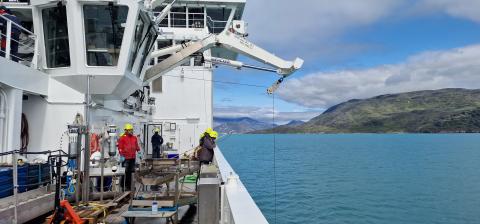
Since we arrived in our study area on the 17th of July, we have sampled almost the full length of the Igaliku Fjord. We had some intensive working days, combining pelagic and benthic sampling, fishing, lab incubations and a lander deployment. However, the overall success of the campaign so far is a strong incentive for everybody on board to get the most out of it. We start early in the morning often at sunrise and some of us continue until after midnight to finish the lab work. The collaboration between scientific teams goes very smoothly and also between scientists and crew, the coordination happens in an optimal way. The RV Belgica has proven to be a fully operational, high tech vessel that can operate successfully in sub-Arctic conditions as we experience it here.
On top of all the hard work we exceptionally enjoyed yesterday a three hours walk on shore in Qaqortoc while bunkering. To see how a small remote town is surviving in these often extreme conditions is a unique experience. The town is small, but cozy and surprisingly lively. The views over the city and harbor at some of the higher points are magnificent.
Now heading to the head of the Igaliku fjord, the change in water color shows us the glacial input coming from land. Also the biological gradients in the water column are becoming much more pronounced here over relatively short distances.
After some cloudy and even rainy days the sun is brightening up the fjord landscape finally. Except for an isolated farm there are not much signs of human activity here on shore. We hope to finish soon the work in this area, in order to set sail to the Ikersuaq fjord influenced by a marine terminating glacier.
Follow us on https://www.instagram.com/marinebiologyugent/
Follow me on my trip ‘Greenland with RV Belgica ’ at this Polarsteps account: